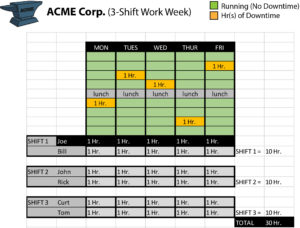MACHINE TIME & LABOR TIME
Knowing what machine downtime costs can easily be found by contacting Accounting for the machine’s amortization schedule. It can also be calculated through lost revenue from reduced production during the down period. The savvy manager puts both together to get an accurate number for what a machine costs a company when it isn’t running.
Some firms may not look as deeply with labor. Many times, that lost time is unaccounted for or labor is simply put into the fixed cost row of the company’s income statement. In today’s environment, labor costs are increasing rapidly. Lost hours can stack up quickly to large hidden costs on the floor. Increasingly, those idle hours are an expense that shouldn’t and can’t be ignored.
CALCULATING IDLE TIME
How do you calculate those costs? Using the simplest method, the number of hours not attributed to production are multiplied by the true hourly cost of employing the worker. That true cost would be the pre-tax wages plus the company’s cost of benefits divided by the hours worked. For instance, if a worker is making $20 an hour, a more correct hourly cost may be $20 plus an extra 30% for benefits. That puts the total closer to $26 an hour. Putting this number into practice, if that worker has an hour a day of time that cannot be accounted directly to making parts, then the cost to the firm is $130 a week. That may not seem so bad.
What happens when it’s a three-shift process that actually requires the floor to use two workers instead of the one worker it estimated for? For every shift, the firm is paying $260 more to produce the parts. In a month, the firm is losing over $3,000. That’s nearly the monthly payment on a new $250,000 machine!
WITH THE HELP OF MES
For most manufacturers, it may be difficult to get the granularity necessary to measure these losses. What savvy managers do is engage a Manufacturing Execution System (MES) to monitor utilization and efficiency on the shop floor. These systems can record labor job-ons & job-offs and directly process productivity metrics.
The MES provides not only more precise labor measurements, but the ability to understand them as they happen - not after numbers are accumulated at the end of the shift or week. That means a manager can essentially know and react as issues occur rather than after a shift or more. What’s more, an MES can provide this ability at a fraction of the cost of a machine tending automation system.
If you’re thinking it’s time to track labor costs more effectively or are interested in how an MES system can provide similar abilities for your operation, contact us today!
ISE & Paper-Less
Leveraging over 35 years in the business technology
industry focused on discrete manufacturing, we know
how to provide an accurate representation on whether
our core competencies can meet your business needs



